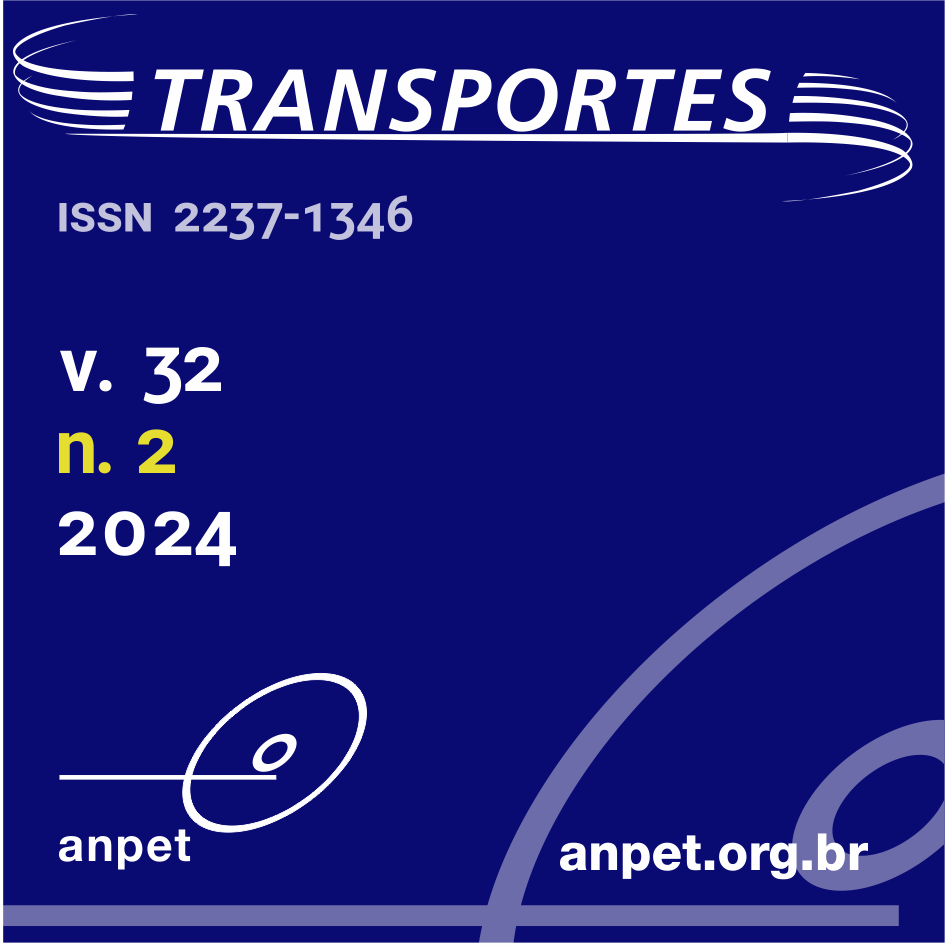Evaluation of automated detection of pavement defects using YOLOv3: impact of collection techniques
DOI:
https://doi.org/10.58922/transportes.v32i2.2796Keywords:
Pavement, Data collection, Deep learningAbstract
This study involved training six neural networks with tailored configurations to automatically detect problems in pavements, utilizing the YOLOv3 framework. The acquisition of images and videos depicting pavement defects was conducted using smartphones and action cameras, leading to the organization of six distinct datasets. Every neural network was subjected to training and validation with the goal of attaining optimal accuracy in automated object detection. Implementing YOLOv3 facilitated effective defect surveys, enhancing the assessment of pavement quality, and offering valuable information for decision-making in road transport management. Upon concluding the investigation, it was determined that the framing method with the highest efficacy attained a precision rate of 98%. The results demonstrate the efficacy of YOLOv3 in accurately detecting defects, underscoring the significance of data collecting and framing methods, and adding to the current body of knowledge on automated pavement defect detection.
Downloads
References
Balbo, J.T. (2007) Pavimentação Asfáltica: Materiais, Projeto e Restauração. São Paulo: Oficina de Textos.
Espíndola, A.C.; G.T.M. Freitas and E.F. Nobre Jr. (2021) Pothole and patch detection on asphalt pavement using deep convolutional neural network. In Proceedings of the Joint XLII Ibero-Latin-American Congress on Computational Methods in Engineering; III Pan- American Congress on Computational Mechanics, ABMEC-IACM. Rio de Janeiro: ABMEC, p. 1-7. Available at: (accessed 03/23/2022).
Everingham, M.; L.V. Gool; C.K.I. Williams et al. (2010) The pascal visual object classes (voc) challenge. International Journal of Computer Vision, v. 88, n. 2, p. 303-338. DOI: 10.1007/s11263-009-0275-4. DOI: https://doi.org/10.1007/s11263-009-0275-4
Haykin, S. (1998) Neural Networks: A Comprehensive Foundation. Hoboken: Prentice Hall PTR.
Hoang, N.D. (2018) An artificial intelligence method for asphalt pavement pothole detection using least squares support vector machine and neural network with steerable filter-based feature extraction. Advances in Civil Engineering, v. 2018, p. 7419058. DOI: http://doi.org/10.1155/2018/7419058. DOI: https://doi.org/10.1155/2018/7419058
Khan, A.I. and S. Al-Habsi (2020) Machine learning in computer vision. Procedia Computer Science, v. 167, n. 13, p. 1444-1151. DOI: 10.1016/j.procs.2020.03.355. DOI: https://doi.org/10.1016/j.procs.2020.03.355
Maeda, H.; Y. Sekimoto; T. Seto et al. (2018) Road damage detection using deep neural networks with images captured through a smartphone. Computer-Aided Civil and Infrastructure Engineering, v. 33, p. 1127-41. DOI: 10.1111/mice.12387. DOI: https://doi.org/10.1111/mice.12387
Padilla, R.; S.L. Netto and E.A.D. Silva (2020) A survey on performance metrics for object-detection algorithms. In Proceedings of the 2020 International Conference on Systems, Signals and Image Processing (IWSSIP). USA: IEEE, p. 237-242. DOI: 10.1109/ IWSSIP48289.2020.9145130. DOI: https://doi.org/10.1109/IWSSIP48289.2020.9145130
Paterson, W.D. (1987) Road Deterioration and Maintenance Effects: Models for Planning and Management. Baltimore: The Johns Hopkins University Press.
Prince, S.J. (2012) Computer Vision: Models, Learning, and Inference. Cambridge: Cambridge University Press. DOI: 10.1017/ CBO9780511996504. DOI: https://doi.org/10.1017/CBO9780511996504
Radovic, M.; O. Adarkwa and Q. Wang (2017) Object recognition in aerial images using convolutional neural networks. Journal of Imaging, v. 3, n. 2, p. 21. DOI: 10.3390/jimaging3020021. DOI: https://doi.org/10.3390/jimaging3020021
Redmon, J.; S. Divvala; R. Girshick et al. (2016) You only look once: unified, real-time object detection. In Proceedings of the IEEE Conference on Computer Vision and Pattern Recognition (CVPR). USA: IEEE, pp. 779-788. Available at: <https://www.cv-foundation. org/openaccess/content_cvpr_2016/html/Redmon_You_Only_Look_CVPR_2016_paper.html> (accessed 03/19/2021). DOI: https://doi.org/10.1109/CVPR.2016.91
Sasaki, Y. (2007) The truth of the F-measure. Teach Tutor Mater, v. 1, n. 5, p. 1-5. Available at: <https://nicolasshu.com/assets/ pdf/Sasaki_2007_The%20Truth%20of%20the%20F-measure.pdf> (accessed 02/12/2021).
Sholevar, N.; A. Golroo and S.R. Esfahani (2022) Machine learning techniques for pavement condition evaluation, Automation in Construction, v. 136, p. 104190. DOI: 10.1016/j.autcon.2022.104190. DOI: https://doi.org/10.1016/j.autcon.2022.104190
Downloads
Published
How to Cite
Issue
Section
License
Copyright (c) 2024 Gabriel Tavares de Melo Freitas, Ernesto Ferreira Nobre Júnior, Aline Calheiros Espíndola

This work is licensed under a Creative Commons Attribution 4.0 International License.
Authors who submit papers for publication by TRANSPORTES agree to the following terms:
- The authors retain the copyright and grant Transportes the right of first publication of the manuscript, without any financial charge, and waive any other remuneration for its publication by ANPET.
- Upon publication by Transportes, the manuscript is automatically licensed under the Creative Commons License CC BY 4.0 license. This license permits the work to be shared with proper attribution to the authors and its original publication in this journal, and to be adapted for non-commercial purposes, provided appropriate credit is given and any derivative works are distributed under the same terms.
- Authors are authorized to enter into additional separate contracts for the non-exclusive distribution of the version of the manuscript published in this journal (e.g., publishing in an institutional repository or as a book chapter), with recognition of the initial publication in this journal, provided that such a contract does not imply an endorsement of the content of the manuscript or the new medium by ANPET.
- Authors are permitted and encouraged to publish and distribute their work online (e.g., in institutional repositories or on their personal websites) after the editorial process is complete. As Transportes provides open access to all published issues, authors are encouraged to use links to the DOI of their article in these cases.
- Authors guarantee that they have obtained the necessary authorization from their employers for the transfer of rights under this agreement, if these employers hold any copyright over the manuscript. Additionally, authors assume all responsibility for any copyright infringements by these employers, releasing ANPET and Transportes from any responsibility in this regard.
- Authors assume full responsibility for the content of the manuscript, including the necessary and appropriate authorizations for the disclosure of collected data and obtained results, releasing ANPET and Transportes from any responsibility in this regard.









